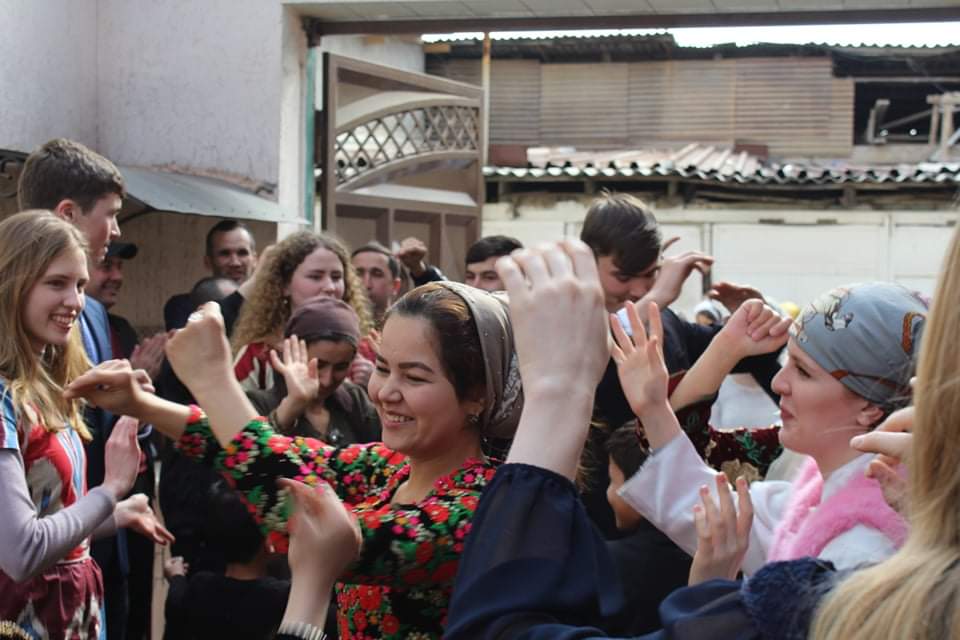Тӯйҳои тоҷикӣ бахшҳои зиёду гуногун доранд, аммо ҳар марҳила хӯрдани бисёр ошро дар бар мегирад! Ҳафтаи гузашта ман дар Душанбе ‘ҷӯраи домод’ барои тӯйи дӯстам будам. Анъанаҳои арӯсӣ дар вилоятҳову минтақаҳои гуногуни Тоҷикистон хеле фарқ мекунанд, бинобар ин ман таҷрибаи худамро ба шумо баён мекунам.
1. Хостгорӣ. Берозигии ҳама хешу табори ҳар ду оила тӯй баргузор намегардад. Дар мисоли оилаи дӯстам, ҳамаи занони оилааш ба Қӯрғонтеппа, ки шаҳре дар ҷануби Тоҷикистон ҷойгир аст, рафтанду арӯси ояндаро хабар гирифтанд. Ин духтари бечора бояд барои ҳама ин бибиёни интиқодгир (критично) меҳмонавозӣ мекард! Баъд онҳо қарор медиҳанд, ки арӯс нағз аст ё не барои домоду оилаашон.
2. Оши нахорӣ. Саҳаре, одатан ду-се рӯз пеш аз тӯй, мардон – фақат мардон – аз оилаи домод оши наҳориро пухта мехӯрданд. Ин ош барои дустӣ байни ҳамсоягону ҳамкорони домод пеш аз тӯй хеле муфид аст.
3. Никоҳ. ‘Никоҳ’ номи бахши мазҳабии тӯй аст, ки барои машрӯъ кардани тӯй дар чашмҳои худо даркор мебошад. Дар тӯй, ки ман рафтаам, ҳама пеши ҳавлии арӯс рафтанду як мулло омаду никоҳро иҷро кард. Ба ғайр аз ин, ҳама дар никоҳ тухуме, ки дар дохили халтачаи зебову рангоранг буд, хӯрданд.
4. Ақди никоҳ (ба русӣ ЗАГС). Барои тӯй қайди ақди никоҳи расмӣ ҳатмӣ аст. Онҳо ба идораи ақди никоҳ рафта дар онҷо шаҳодатномаи ақди никоҳ мегиранд.
5. Рӯзи тӯй ё рӯйбинон. Дар субҳи рӯзи тӯй ҳама барои гирифтани арӯс ба хонааш мераванд ва аз пушти чодар ӯро мегиранд. Чизе, ки хеле аҷоиб аст, ин як навъи бозӣ бо номи харидани арӯс аст. Ман (бечора) ба падараш 200 сомонӣ додам чунки ин бозӣ вазифаи ҷӯраи домод аст. Вақте ки арӯс ба хонаи домод мерасад, ҳама мерақсад ва бо ин келин навро хайра мақдам мегӯянду ба ӯ тӯҳфа медиҳанд. Баъд бештар ош мехӯрем. Дар охири рӯз келини нав дастҳояшро дар як коса бо гулу равғани атриёт мешуяд.
Саранҷом, рӯзҳое баъд аз тӯй, арӯсу домод бояд дар муддати чил рӯз аз ҳамдигар ҷудо нашаванд.

Tajiki weddings have many different parts, but each stage includes eating lots of osh (rice cooked with carrots and meat in a big wok)! Last week I was the best man at a friend’s wedding in Dushanbe. Wedding traditions in the different regions of Tajikistan differ, so I’m going to tell you about my own experience.
1. Matchmaking. Without the approval of all the relatives of both families, the wedding will not take place. In the case of my friend’s wedding, all the female relatives went to Qurghonteppa, a city located in the south of Tajikistan, to visit the future wife. This poor girl had to play host to all the critical grandmas! Then the relatives make the decision about whether the girl will be a good bride for the family or not.
2. ‘Oshi nahori’ (morning osh). One morning, normally two-three days before the wedding, the men – only the men – from the groom’s family prepare and eat osh. This meal is important before the wedding for the friendship between the groom’s family’s neighbours and colleagues.
3. ‘Nikoh’ is the name for the religious part of the wedding, which is necessary for validating the wedding in the eyes of god. At the wedding that I went to, everyone went to the bride’s house and a mullah came to perform the nikoh. Also, everyone at the nikoh ate boiled eggs that were inside beautiful little colourful bags.
4. Wedding certificate (ZAGS in Russian). For the wedding an official marriage certificate is obligatory. The bride and groom went to the registration office to take the certificate.
5. The wedding day or ‘ruibinon’ (bridal reveal). The morning of the wedding everyone goes over to the bride’s house to pick her up and take her out from behind the ‘chodar’ (veil in which the bride stands behind). Something which is interesting is a kind of game called ‘kharidani arus’ (the buying of the bride). I gave 200 somoni to the father of the bride because this tradition is the best man’s job. When the bride arrives at the groom’s house, everyone dances and welcomes the new ‘kelin’ (daughter-in-law) and gives her gifts. Then we eat more osh! At the end of the day the new kelin washes her hands in a bowl with flowers and perfumed oil.
Finally, after the wedding, the bride and groom must stay together for 40 days without leaving each other’s side.
